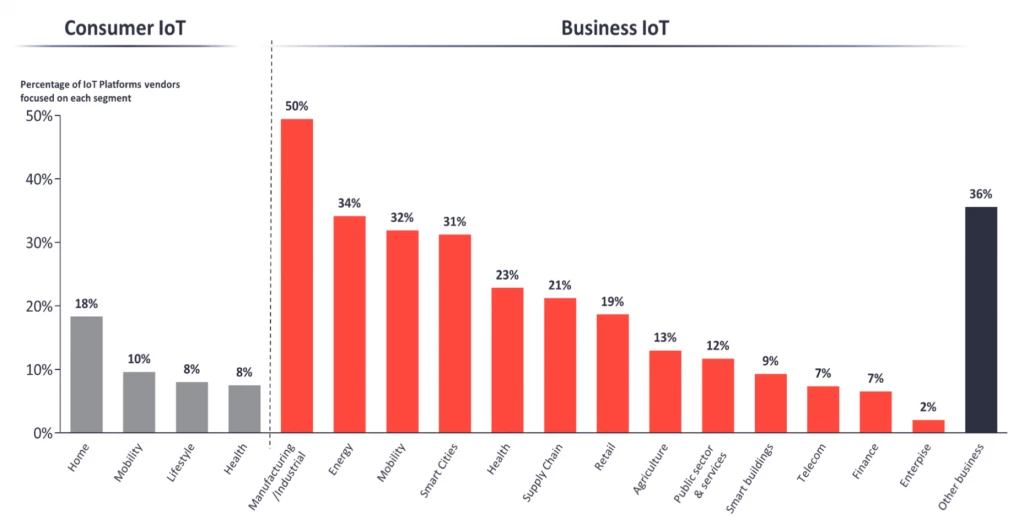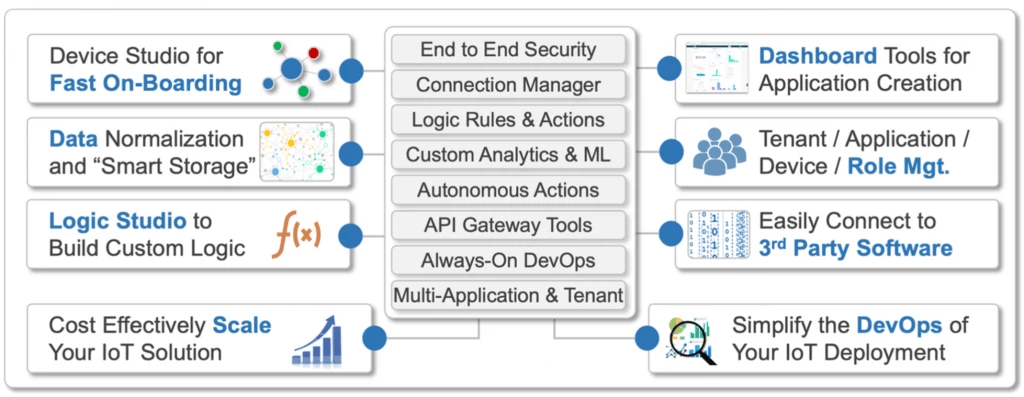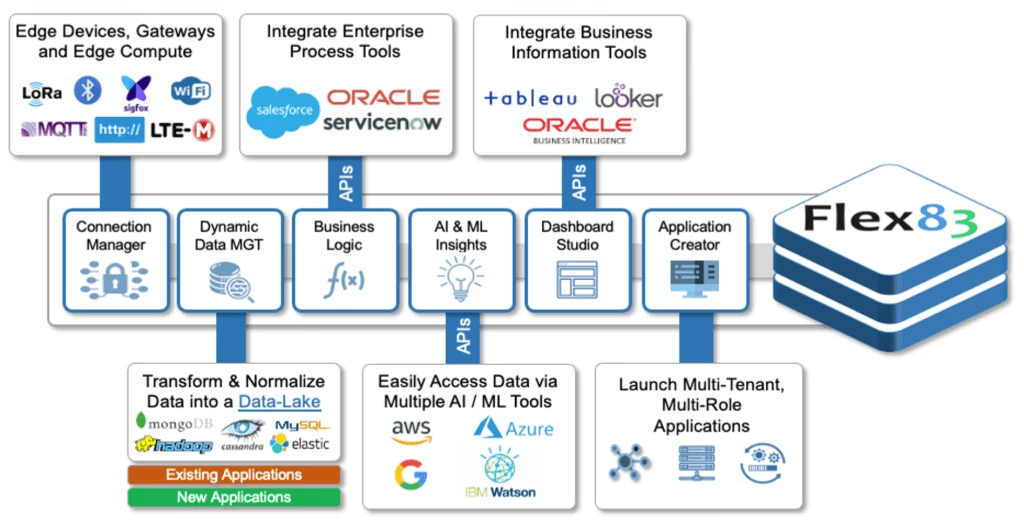
Introduction: The Essential Element for Rapid Application Development
The important economic value of the Internet of Things (IoT) applications is becoming apparent to almost all enterprises from industrial process applications, to smart manufacturing / lighting / buildings / lighting / cities / energy, and more, across virtually all industries verticals. According to a recent Kaspersky study, 61% of businesses are using the internet of things to bolster their operations. Still, we remain at the foot of the curve with many gains ahead as the IoT ecosystem makes it easier for enterprises to fully implement IoT solutions. Application Enablement Platforms and Rapid Application Development will be a key part of this.
The chart below from IoT analytics shows the continued focus & growth of IoT, but IoT remains at the foot of the curve relative to the huge potential value to businesses. The availability of AEPs and RAD will be a major factor in unleashing this new value.

AEPs – The Need for Better IoT Application Enablement
And now, the advent of Application Enablement Platforms (AEP) provides enterprises, OEMs, and service providers with far lower cost, risk, and time to market paths for IoT project success. AEPs now provide a secure, stable, and scalable underlying platform, combined with robust sets of application creation tools, which combined streamline the creation, validation, launch, and scale of powerful IoT solutions. Using the AEP approach IoT projects no longer need to bear the burdensome cost, time to market, and risk of failure required when building, constructing entire from-scratch solutions that they did in the pre-AEP era. Thanks to AEPs IoT deployments can be based on proven IoT plumbing and enterprises can leverage the AEP No-Code / Low-Code / and Full-Code workflows to build powerful fully custom IoT applications fast.
IoT83’s AEP, branded as Flex83 (or white-labeled for customers) was built to democratize industrial IoT making it far easier for customers to build either simple or highly sophisticated IoT applications fast and affordably. Flex83 provides both a No-Code click-to-configure workflow, as well as an intuitive framework for Low-Code custom application creation; including API gateway (for secure restful interworking), function as a service (FaaS) tools for algorithm and analytics integration, dynamic ETL for data transformations, dashboard and application creation tools, identity access management, and much more. Finally, Flex83 also provides for Full-Code workflows, allowing customers to lift the hood and deploy custom code blocks, algorithms, analytics, or other functionality as integrated platform elements – all in a cleanly containerized manner. With these capabilities, the IoT application creation becomes a whole new ball game.
Rapid Application Development – What’s Different and Why it Matters
The advent of AEPs set the stage for Rapid Application Development, or RAD, for IoT.
But first, what is RAD? According to Capterra, Rapid Application Development (RAD) is a form of agile software development methodology that prioritizes rapid prototype releases and iterations. Unlike the waterfall method, RAD emphasizes the use of software and user feedback over strict planning and requirements recording.
Bottom-line: Achieving agile R&D velocity, or RAD, in the inherently complex world of IoT application Development Platforms is powerful and groundbreaking.
Agile development has been embraced industry-wide as an excellent high-velocity methodology for efficient software development. Multiple cycles of planning, designing, building, testing, and validating, with working product available at the end of each sprint drive a focus and discipline – as well as velocity – that is lacking in waterfall methods (for the waterfall, think long multi-dependency Gantt chart models). The shorthand illustration of a multi-sprint model for agile product development is shown below:

But, for very large projects that span long periods of time and multiple sprints, the non-deterministic time-to-market aspects of agile can seem (and actually be) too high-risk for business leaders to embrace. And, in the pre-AEP world, many agile-driven IoT projects did fail or fall short of program goals, simply based on the scope and complexity undertaken.
But the availability of powerful Application Enablement Platforms changes the game completely. Now, even very sophisticated IoT projects can leverage an agile approach, with iterative cycles of planning, designing, building, testing, and validating, with working product IoT functionality available at the end of each sprint. This is RAD.
No longer burdened with the underlying IoT platform plumbing, and using platform functionality that just works. Using fast application creation tools available in an AEP system, IoT solutions that used to take quarters or years to build can now be built in months, weeks, or even days.
A diagram of the RAD development cycle is shown below:

How RAD Drive Higher Program Velocity and Program Success
Leveraging RAD methodologies and underlying AEP technology, small teams can produce powerful platforms in a very short time. Previously, R&D teams would spend some 80% of the program cost and timeline on platform and infrastructure features and only 20% on actual value creation of the application for customers. Now, the almost entire budget can be spent on customer value creation. This equates to dramatically lower costs while also delivering much higher value.
And, because the costs and cycle times are dramatically reduced, IoT project features and functionality can be quickly built and then validated with customers, followed by another fast iteration to bake in customer feedback. Incremental development and deployment with working functionality can be rolled out rapidly – back again to the agile development model.
The Rapid Application Development model emphasizes speed as well as agility. RAD stresses iterative cycles with contained but crisp planning, rapid prototype, and test cycles, followed by customer validation and refinement. RAD is inherently iterative, refining features of prior iterations, and layering on new values with each cycle. The result is a significant increase in productivity and the value of project results. Platforms like Flex83 are at the core of this RAD process and allow businesses to deliver projects not just in years, quarters or months but in a matter of weeks or days. Creating a production-ready application at a faster pace means that the business can benefit from early solution availability, while new functionality continues to be released at later stages. All at lower cost, risk, and time to market!
The Many Benefits of the Rapid Application Development Process
The benefits of RAD are somewhat intuitive, but here we take a closer look at what enabling Rapid Application Development can mean to business program success rates:
Risk Reduction: The ability to rapidly create and share working prototypes, lets the business review functionality earlier in the application life cycle, facilitating in avoiding rework that could disrupt the entire project. Rapid Application Development methodology’s time-box approach mitigates cost and reduces risk.
Quick Delivery: Rapid Application Development ensures quick delivery by applying iterative releases and code reusability on a model-driven, Low-Code platform. This allows businesses to focus less on overwrought processes and documentation resulting delivery of solutions on time.
Improved Quality: Incorporating prototyping and functionality testing throughout the project life cycle increases software quality as requirements can be validated and developed based on user feedback.
Better Productivity: In RAD, the client is involved every step of the way and the developer has the opportunity to present their work frequently. This gives the developer a certain level of confidence that when the final product is delivered, thus greatly improving developer productivity.
Greater customer satisfaction: As the customer is involved throughout the development cycle, the risk of not achieving client satisfaction and business needs is minimized.
Reduced Costs: Rapid Application Development framework requires short, agile sprints that repeat as frequently as the project requires. This iterative approach uncovers bugs and logic issues before they can derail delivery. The shortened cycle time improved productivity and fewer resources significantly reduce the cost of application development.
The Flex83 AEP / RAD Solution
The Flex83 Rapid Application Development platform provides a solid underlying IoT elastic core, combined with AEP fast application enablement tools and workflows that allow development at a truly agile pace – enabling the dramatic benefits of RAD. With the reliable/flexible/scalable underlying IoT platform and the powerful integrated AEP tools, very fast application development cycles are possible, customer validation can be near real-time, and everything is – always – ready to launch and scale on the underlying high-performance platform.
The impact of this across the entire enterprise is high: New products can be envisioned and prototyped rapidly; new services can be rolled out in an agile fashion as soon as they are available; specialized services can be deployed for unique customer needs; the cost of engineering is far lower, schedules are shorter, and products are released with a much higher velocity and quality. From an overall cost of, value creation, every dollar you spend for application creation is now focused on the actual customer need at hand, and not underlying technology or re-inventing the wheel from an operation and platform management perspective. The AEP / RAD approach provides all of this. And the impact to cost, risk, time to market, and overall program effectiveness is again – dramatic. Using this approach, IoT83 customers see increases in overall efficiency increase by up to 80%, and this does not even take other intangible benefits – such as an improved focus on solution creation, improved portfolio value perception, market leadership, or customer satisfaction – into account.
Below is a high level representation of the Flex83 platform with all of the built-in capabilities that enable this RAD approach:

The Flex83’s No-Code / Low-Code / Full-Code application development models and workflows work allow not only stand-alone IoT application creation, but also, using the built-in connectors and API creation allows applications to interwork with other enterprise software, third party systems, other middleware, business insight tools, or whatever the unique and end-to-end total solution may require. An illustration of this follows:

- Multiple system communication and intelligence
- Data transformations and normalization.
- The addition of new business logic and more – all can be executed in the fast paced RAD execution model.
IoT83’s Flex83 platform offers fast-paced innovation across the full enterprise for a full continuum of enablement – from ideation to prototyping, to validation, to launch, to scale, to iterative life-cycle solution enhancements – all leveraging the RAD approach, and without high levels of investment. It is easy to see how this will transform and benefit program success and business ROI.
And, built for teamwork, Flex83 simplifies team alignment and helps the entire enterprise work together to deliver powerful and successful projects both successfully and quickly.
Conclusions
Rapid Application Development’s agile approach lets businesses commence with an idea, build a proof of concept, validate the idea in the market, quickly optimize the solution, and successfully launch… and easily improve and expand the solution over time as new market insights or customer needs arise. Leveraging an AEP like Flex83 provides enterprises with the underlying platform, tools, and workflows to enable this effective and powerful RAD process. Companies can realize fast results and immediate impact from IoT project investments for themselves or their customers… and then move on to the next expansion iteration, new ideas, or new portfolio enhancements. The RAD agile approach combined with the ground-breaking Flex83 platform delivers groundbreaking transformation for IoT value creation.
Discover more about the capabilities and value that the Flex83 Rapid Application Development solution can deliver to your business.
